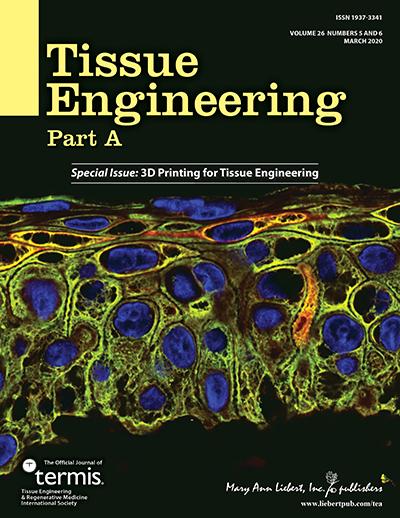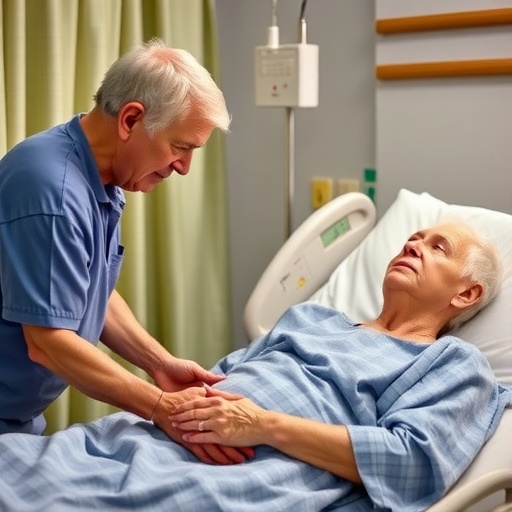
Credit: Mary Ann Liebert Inc., publishers
New Rochelle, NY, April 15, 2020–For optimally engineered tissues, it is important that biological cues are delivered with appropriate timing and to specific locations. To aid in this endeavor, researchers have combined acoustic droplet ejection (ADE) technology with 3D printing to establish stringently controlled growth factor patterning in porous constructs. Their work is reported in Tissue Engineering, a peer-reviewed journal from Mary Ann Liebert, Inc., publishers. Click here to read the article for free on the Tissue Engineering website through May 14, 2020.
In “Acoustic Patterning of Growth Factor for 3D Tissue Engineering,” Yunzhi Peter Yang, PhD, Stanford University, and coauthors report the establishment of this new combination method. The authors started with biodegradable polycaprolactone (PCL) constructs, which were terminated with succinimide as test material or with sodium hydroxide or fibrin as controls, and then used ADE to deposit bone morphogenetic protein 2 (BMP-2) in precise locations throughout the lattice. C2C12 mouse myoblast cells were incubated with the constructs, and the osteogenic differentiation of these cells was monitored by alkaline phosphatase (AP) staining. The PCL-succinimide samples showed AP staining mirroring the patterned BMP-2 spots, thus demonstrating the potential of ADE growth factor patterning in tissue engineering.
“This novel combination of 3D printing and ADE technologies addresses the crucial need for high spatial resolution of growth factor presentation in tissue engineered constructs,” says Tissue Engineering Co-Editor-in-Chief Antonios G. Mikos, PhD, Louis Calder Professor at Rice University, Houston, TX. “While the use of this technology demonstrated great success in osteogenic differentiation, these techniques will also be tremendously beneficial to many other tissue types as well.”
###
About the Journal
Tissue Engineering is an authoritative peer-reviewed journal published monthly online and in print in three parts: Part A, the flagship journal published 24 times per year; Part B: Reviews, published bimonthly, and Part C: Methods, published 12 times per year. Led by Co-Editors-in-Chief Antonios G. Mikos, PhD, Louis Calder Professor at Rice University, Houston, TX, and John P. Fisher, PhD, Fischell Family Distinguished Professor & Department Chair, and Director of the NIH Center for Engineering Complex Tissues at the University of Maryland, the Journal brings together scientific and medical experts in the fields of biomedical engineering, material science, molecular and cellular biology, and genetic engineering. Leadership of Tissue Engineering Parts B (Reviews) and Part C (Methods) is provided by Katja Schenke-Layland, PhD, Eberhard Karls University, Tübingen, Heungsoo Shin, PhD, Hanyang University; and John A. Jansen, DDS, PhD, Radboud University, and Xiumei Wang, PhD, Tsinghua University respectively. Tissue Engineering is the official journal of the Tissue Engineering & Regenerative Medicine International Society (TERMIS). Complete tables of content and a sample issue may be viewed on the Tissue Engineering website.
About the Publisher
Mary Ann Liebert, Inc., publishers is a privately held, fully integrated media company known for establishing authoritative peer-reviewed journals in many promising areas of science and biomedical research, including Stem Cells and Development, Human Gene Therapy, and Advances in Wound Care. Its biotechnology trade magazine, GEN (Genetic Engineering & Biotechnology News), was the first in its field and is today the industry’s most widely read publication worldwide. A complete list of the firm’s 90 journals, books, and newsmagazines is available on the Mary Ann Liebert, Inc., publishers website.
Media Contact
Kathryn Ryan
[email protected]
Related Journal Article
http://dx.




